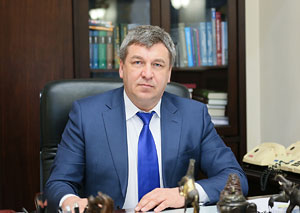
Moscow Reverts to Siberian Migration to Bolster Ethnic Russian Presence in Stavropol
Publication: Eurasia Daily Monitor Volume: 10 Issue: 222
By:

On December 4, Russian Minister for Regional Development Igor Slyunyaev stated that the country’s population should be resettled along the borders and in the coastal areas. This strategy, according to the minister, should resolve the problem of the underdevelopment of Russia’s remote areas—most principally, the Far East and Siberia. Slyunyaev said that Russia must use the experience of Canada and Australia and establish population centers on the borders and coasts while developing the inner areas of the country through temporary shifts of the workforce. Meanwhile, experts say that there are no “extra” people in Russia who can be sent to the borders. Also after a large outflow of population from the Russian Far East and Siberia in 1990s following the collapse of the Soviet Union, the population of those regions stabilized at 6.3 million people and 19.3 million, respectively. The climate in these remote areas is so harsh that they are unlikely to attract many more people (https://www.vedomosti.ru/opinion/news/19672721/slyunyaevskie-vagony).
In a recent commentary published in the newspaper Vedomosti, the Russian economist-geographer Natalya Zubarevich argued that the centralization of power in Russia reached the point at which its ineffectiveness can no longer be ignored. According to Zubarevich, all political forces in Russia fear that the country’s vast territory makes it inherently prone to falling apart. He argues that the drive for centralization, which stems from this fear, renders the country’s economic policies insensitive to territorial differences and stalls economic development. Zubarevich asserted that Russia has no resources for developing the massive eastern territories and must attract foreign investors. However, foreign investment will not take off unless the regions are given economic freedoms and corresponding responsibilities. The Russian scholar noted that the inefficiencies of centralization result in peculiar and non-transparent actions. He pointed to Chechnya, which received a whopping 22 percent of all budgetary assistance to the regions in the Russian Federation during the period of January to July 2013 (https://www.vedomosti.ru/opinion/news/18983151/strashilki-ekonomicheskogo-separatizma).
Zubarevich reassured that fears of Russia’s proneness to disintegration are overblown, given the built-in unity of the ethnic Russian nation. It is ethnic non-Russians, however, that Moscow is most worried about.
Regional Development Minister Slyunyaev continued making his groundbreaking revelations about government policies on migration at a meeting with Cossacks and Orthodox military chaplains. “We have developed a concept of priority resettlement of compatriots who are willing to return from abroad to Russia,” he said. “Currently, the Trans-Baikal and Far East regions are listed as such territories. I am now decreeing to add the North Caucasian regions to them, first of all the Stavropol region.” The official said that an estimated 25 million “potential compatriots” were willing to relocate to Russia. The numbers did not match up, however, when he mentioned that only 250,000 Russians had moved to Russia from abroad in the previous seven years (https://www.km.ru/v-rossii/2013/12/06/federalnaya-migratsionnaya-sluzhba-rf/727013-v-minregione-predlozhili-zaselit-se).
By proposing to designate Stavropol region as a border area that should be populated with Russian settlers, Slyunyaev inadvertently confirmed that Moscow implicitly regards Stavropol as a border region in the North Caucasus, meaning that the North Caucasian republics south of Stavropol region are seen as a quasi-foreign area. Stavropol officials and civil activists have emphasized that the government should do more to preserve its status as a majority ethnic-Russian region. Paradoxically, ethnically non-Russian North Caucasians who resettle in Stavropol are treated as foreign invaders who should be held back.
The Russian Orthodox Church willingly plays a prominent part in this Russian nationalist mobilization campaign. At a meeting with Minister Slyunyaev, Metropolitan Kirill of Stavropol said about 2,000 ethnic Russian families from Kazakhstan and Kyrgyzstan were willing to resettle in Stavropol region. “We are ready to build three, four, five, ten settlements for the settlers,” he said. “This will become a mighty impulse for the local population” (https://www.km.ru/v-rossii/2013/12/06/federalnaya-migratsionnaya-sluzhba-rf/727013-v-minregione-predlozhili-zaselit-se).
Migration patterns in the eastern and southern districts of Stavropol region have increasingly become a source of concern for Russian nationalists and officials. As ethnic Russians have moved out of economically depressed areas, North Caucasians, mostly Dagestanis and Chechens, have moved in to take the jobs in agriculture that Russians did not want. Another motivation for the North Caucasians’ move to Stavropol region was its relative safety compared to the situation in their respective republics, where security service operations and abuses of power are the norm.
From an economic point of view, the dynamics seem to be a “win-win” situation: as a skilled ethnic-Russian workforce moves to the big cities from eastern areas of Stavropol region, it is replaced by a low-skilled workforce from the relatively overpopulated republics of the North Caucasus. However, the changing ethnic map of Stavropol region touches on Russian sensitivities so much that the replacement of ethnic Russians by North Caucasians is recast as a clash of civilizations. In the process, the Russian government further entrenches the divide between the country’s ethnic-Russian population and its non-Russian citizens, especially those in the North Caucasus.
With budget revenues in Russia falling and Moscow struggling with government expenditures, there is increasing discussion about a transition to a more sustainable economic model. Economic considerations are becoming more important as money becomes tight and the North Caucasus is fitting less and less into the equations of Russian economists and nationalists.




